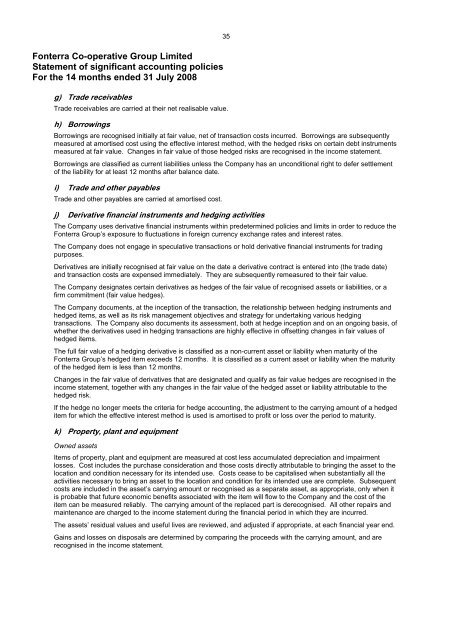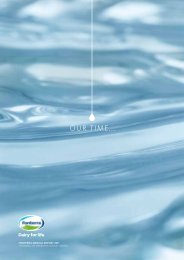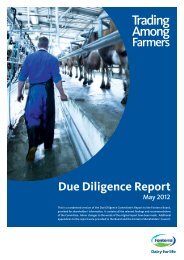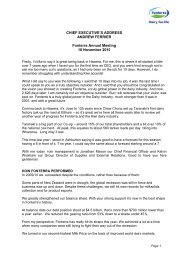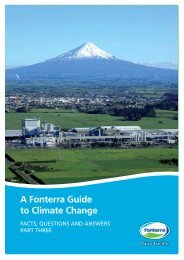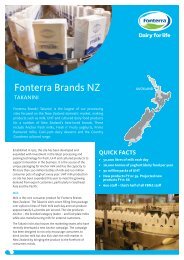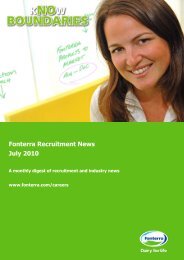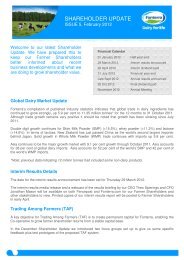Prospectus - Fonterra
Prospectus - Fonterra
Prospectus - Fonterra
You also want an ePaper? Increase the reach of your titles
YUMPU automatically turns print PDFs into web optimized ePapers that Google loves.
<strong>Fonterra</strong> Co-operative Group LimitedStatement of significant accounting policiesFor the 14 months ended 31 July 200835g) Trade receivablesTrade receivables are carried at their net realisable value.h) BorrowingsBorrowings are recognised initially at fair value, net of transaction costs incurred. Borrowings are subsequentlymeasured at amortised cost using the effective interest method, with the hedged risks on certain debt instrumentsmeasured at fair value. Changes in fair value of those hedged risks are recognised in the income statement.Borrowings are classified as current liabilities unless the Company has an unconditional right to defer settlementof the liability for at least 12 months after balance date.i) Trade and other payablesTrade and other payables are carried at amortised cost.j) Derivative financial instruments and hedging activitiesThe Company uses derivative financial instruments within predetermined policies and limits in order to reduce the<strong>Fonterra</strong> Group’s exposure to fluctuations in foreign currency exchange rates and interest rates.The Company does not engage in speculative transactions or hold derivative financial instruments for tradingpurposes.Derivatives are initially recognised at fair value on the date a derivative contract is entered into (the trade date)and transaction costs are expensed immediately. They are subsequently remeasured to their fair value.The Company designates certain derivatives as hedges of the fair value of recognised assets or liabilities, or afirm commitment (fair value hedges).The Company documents, at the inception of the transaction, the relationship between hedging instruments andhedged items, as well as its risk management objectives and strategy for undertaking various hedgingtransactions. The Company also documents its assessment, both at hedge inception and on an ongoing basis, ofwhether the derivatives used in hedging transactions are highly effective in offsetting changes in fair values ofhedged items.The full fair value of a hedging derivative is classified as a non-current asset or liability when maturity of the<strong>Fonterra</strong> Group’s hedged item exceeds 12 months. It is classified as a current asset or liability when the maturityof the hedged item is less than 12 months.Changes in the fair value of derivatives that are designated and qualify as fair value hedges are recognised in theincome statement, together with any changes in the fair value of the hedged asset or liability attributable to thehedged risk.If the hedge no longer meets the criteria for hedge accounting, the adjustment to the carrying amount of a hedgeditem for which the effective interest method is used is amortised to profit or loss over the period to maturity.k) Property, plant and equipmentOwned assetsItems of property, plant and equipment are measured at cost less accumulated depreciation and impairmentlosses. Cost includes the purchase consideration and those costs directly attributable to bringing the asset to thelocation and condition necessary for its intended use. Costs cease to be capitalised when substantially all theactivities necessary to bring an asset to the location and condition for its intended use are complete. Subsequentcosts are included in the asset’s carrying amount or recognised as a separate asset, as appropriate, only when itis probable that future economic benefits associated with the item will flow to the Company and the cost of theitem can be measured reliably. The carrying amount of the replaced part is derecognised. All other repairs andmaintenance are charged to the income statement during the financial period in which they are incurred.The assets’ residual values and useful lives are reviewed, and adjusted if appropriate, at each financial year end.Gains and losses on disposals are determined by comparing the proceeds with the carrying amount, and arerecognised in the income statement.


